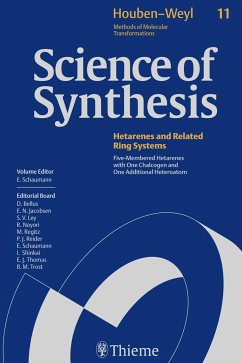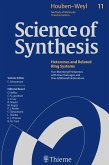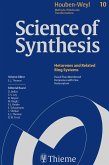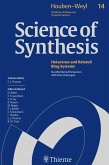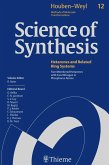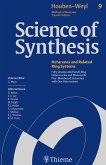Turning Information into Knowledge
Science of Synthesis: Houben-Weyl Methods of Molecular Transformations is the entirely new edition of the acclaimed reference series, Houben-Weyl, the standard synthetic chemistry resource since 1909. This new edition is published in English and will comprise of 48 volumes published between the years 2000 and 2008.
Science of Synthesis is a quality reference work developed by a highly esteemed editorial board to provide a comprehensive and critical selection of reliable organic and organometallic synthetic methods. Science of Synthesis is designed to be the first point of reference when searching for a synthesis strategy.
This volume is the third in Category 2 (Hetarenes and Related Ring Systems) of Science of Synthesis and deals with five-membered hetarenes with one chalcogen and one additional heteroatom. Throughout this category, a hetarene is considered to be a heterocyclic ring with a fully conjugated perimeter of pi- or nonbonding electrons. Additionally, potentially tautomeric systems with a hydroxy, sulfanyl, or amino substituent are included when conjugation is possible at least in one tautomer. In the Volume 11, this formal definition leads to quite different types of five-membered heterocyclic ring systems including the 1,2- or 1,3-arrangement of two chalcogen atoms to give cationic rings, as well as 1,2- or 1,3-combinations of a chalcogen atom and a nitrogen or phosphorus atom. The latter group comprises well-known ring systems such as oxazoles or thiazoles, but also less well-studied ring systems.
For full information on the Science of Synthesis series, visit the Science of Synthesis Homepage. Series Editors: D. Bellus, S. V. Ley, R. Noyori, M. Regitz, E. Schaumann, I. Shinkai, E. J. Thomas, B. M. Trost, P. J. Reider
Science of Synthesis: Houben-Weyl Methods of Molecular Transformations is the entirely new edition of the acclaimed reference series, Houben-Weyl, the standard synthetic chemistry resource since 1909. This new edition is published in English and will comprise of 48 volumes published between the years 2000 and 2008.
Science of Synthesis is a quality reference work developed by a highly esteemed editorial board to provide a comprehensive and critical selection of reliable organic and organometallic synthetic methods. Science of Synthesis is designed to be the first point of reference when searching for a synthesis strategy.
This volume is the third in Category 2 (Hetarenes and Related Ring Systems) of Science of Synthesis and deals with five-membered hetarenes with one chalcogen and one additional heteroatom. Throughout this category, a hetarene is considered to be a heterocyclic ring with a fully conjugated perimeter of pi- or nonbonding electrons. Additionally, potentially tautomeric systems with a hydroxy, sulfanyl, or amino substituent are included when conjugation is possible at least in one tautomer. In the Volume 11, this formal definition leads to quite different types of five-membered heterocyclic ring systems including the 1,2- or 1,3-arrangement of two chalcogen atoms to give cationic rings, as well as 1,2- or 1,3-combinations of a chalcogen atom and a nitrogen or phosphorus atom. The latter group comprises well-known ring systems such as oxazoles or thiazoles, but also less well-studied ring systems.
For full information on the Science of Synthesis series, visit the Science of Synthesis Homepage. Series Editors: D. Bellus, S. V. Ley, R. Noyori, M. Regitz, E. Schaumann, I. Shinkai, E. J. Thomas, B. M. Trost, P. J. Reider

